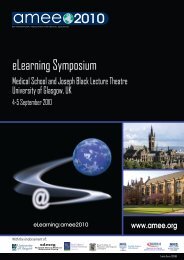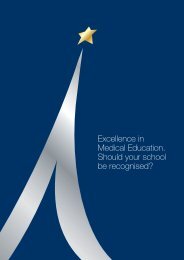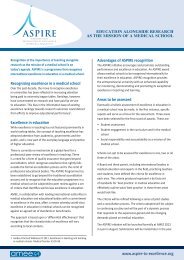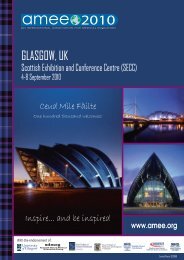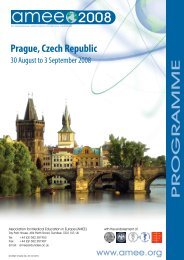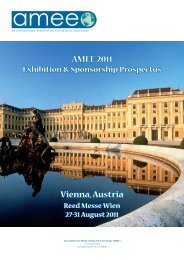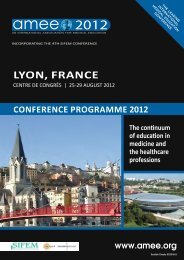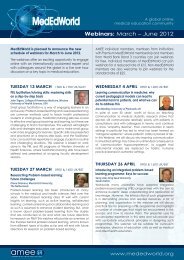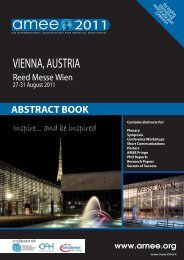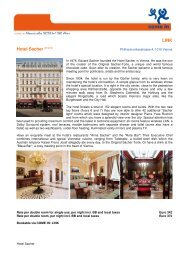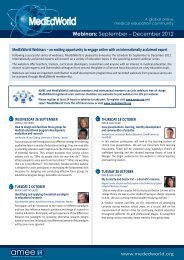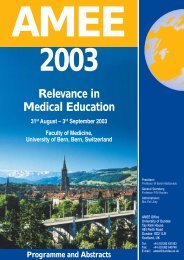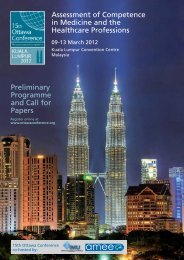AMEE Berlin 2002 Programme
AMEE Berlin 2002 Programme
AMEE Berlin 2002 Programme
You also want an ePaper? Increase the reach of your titles
YUMPU automatically turns print PDFs into web optimized ePapers that Google loves.
feedback that identifies specific learning needs as well<br />
as problematic patterns of behaviour. Students work<br />
with their advisory deans to interpret the feedback and<br />
construct individualized learning plans. An overview<br />
of the various components will be presented as well as<br />
examples of different types of feedback and learning<br />
plans. The value of this comprehensive assessment for<br />
student learning and for curricular planning will be<br />
discussed with attention given to the resources required<br />
for implementation.<br />
2F4 Attributes of the excellent physician:<br />
a third year student survey<br />
A V Carneiro*, M F Patrício and J Fernandes e Fernandes<br />
University of Lisbon School of Medicine, Rua Sousa Lopes, Lote<br />
KL - 8 E, 1600-207 Lisbon, PORTUGAL<br />
Role-modeling is a basic part of medical education.<br />
Sixty-six third year medical students were asked – using<br />
questionnaires with open and closed (Likert scale type)<br />
questions – to indicate their opinions on the attributes<br />
of a good doctor. The students favoured good<br />
humanistic qualities in the relationship with patients<br />
and families (96% good or very good), ability to look<br />
for help when needed in clinical practice (97%),<br />
diagnostic abilities (97%) and honesty and ethical<br />
behaviour (94%). The least important attributes<br />
included leadership (68% little or no importance),<br />
research abilities (71%) and a good general culture<br />
(67%). It is concluded that third year medical students<br />
can define a set of attributes of what they consider to<br />
be a good doctor: these include professional behaviour,<br />
ethics, knowledge and leadership. We will recheck these<br />
results at graduation time (within 3 years).<br />
2F5 The Medical Student Peer<br />
Evaluation Initiative: assessment<br />
of performance in small group<br />
settings<br />
Steven L Kanter*, Kathleen Ryan, John Mahoney and<br />
Joan Harvey<br />
University of Pittsburgh, School of Medicine, M-240 Scaife Hall,<br />
3550 Terrace Street, Pittsburgh PA 15261, USA<br />
Experience with student assessment at the University<br />
of Pittsburgh School of Medicine led to the observation<br />
that, although a faculty facilitator was not identifying<br />
early a student experiencing difficulty in small group,<br />
the student’s peers were generally aware of the problem.<br />
This led to the development of the Medical Student<br />
Peer Evaluation Initiative (PEI), which aims to provide<br />
feedback to students on performance in small group<br />
sessions; recognize students who demonstrate<br />
excellence; identify poorly functioning students and<br />
offer counseling. Each student rates each other group<br />
member on the member’s ability to help the student<br />
learn. If a score pattern indicates a problem, a faculty<br />
overseer meets with the student. Results of the PEI<br />
reveal excellent participation, early identification of<br />
Monday 3 September<br />
- 4.11 -<br />
students with a range of difficulties, and rapid<br />
remediation of most problems. In conclusion, peer<br />
evaluation is a feasible and useful measure of student<br />
small group performance.<br />
2F6 Reliability of a multidimensional<br />
questionnaire to assess attitudes of<br />
medical students towards their<br />
future profession: the UNI Project<br />
G L Werneck*, E C O Ribeiro, A C Aguiar and V M B Ribeiro<br />
Nucleo de Estudos de Saude Coletiva, NESC/UFRJ, Av. Brig.<br />
Trompovsky s/n - HUCFF, 5o andar - Ala Sul, BRAZIL<br />
The objective of this study was to assess the reliability<br />
of answers to questions concerning attitudes of medical<br />
students towards their future profession. We developed<br />
a self-administered questionnaire including 52<br />
questions covering attitudes expected to be developed<br />
by students during medical school. A test-retest design<br />
was used as a preliminary evaluation of the<br />
questionnaire. The questionnaire was completed twice<br />
within a one-week interval by students of the major<br />
university of Rio de Janeiro, Brazil. The test-retest<br />
reliability was estimated by kappa statistics (K).<br />
Twenty-four questions (46%) had K greater than 0.6<br />
(substantial agreement); 13 questions (25%) had K<br />
between 0.4 and 0.6 (moderate agreement); and 15<br />
questions (29%) had K below 0.4 (fair agreement).<br />
Considering the complexity of assessing attitudes, we<br />
judge these preliminary results as satisfactory. The next<br />
step will be to revise and test those questions showing<br />
low agreement.<br />
2F7 Narrowing the gap in the<br />
assessment process<br />
Nicolas Karlsson<br />
Villa Medici, Hogasplatsen 6, 412 56 Goteborg, SWEDEN<br />
The problem with assessment processes in the past has<br />
been to motivate the participants to take an active and<br />
creative part in the process. This requires a narrowing<br />
of the gap between different groups and that the process<br />
stimulates each individual participating. On the<br />
initiative of the student organisation, the Faculty of<br />
Medicine in Göteborg implemented the Course<br />
Committee in year 2000 after three succesful pilot<br />
projects. The Course Committee is the motor in the<br />
assessment process, creating a suitable environment for<br />
communication in close connection to the reality of<br />
each participant. As a meeting point between the<br />
different parts in the educational process it improves<br />
not only the democracy of the organisation necessary<br />
for continuous improvement, but the course committee<br />
also facilitates the translation from the student’s<br />
descriptional language into the defined language of the<br />
manager of the course. A protocol published on the<br />
www preserves the productive dialogue and the<br />
suggestions made.



